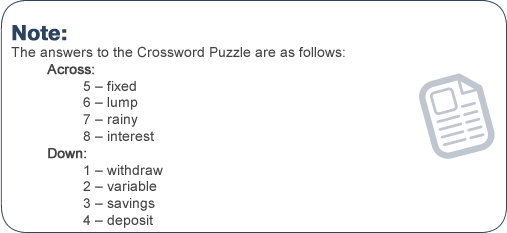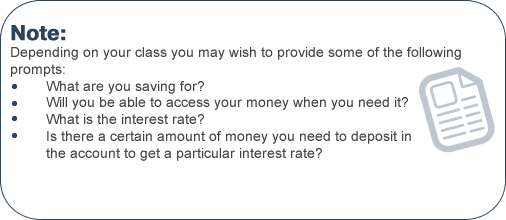Lesson 6: Savings accounts
Introduction

Time:
- Single class period
Materials:
Activity Two: Crossword puzzle
Activity Three: Compound interest
Homework Task:
Useful Links:
Introduction:
There are many savings accounts available and people often find it difficult to choose which one is right for their specific needs. In this lesson, students will become familiar with some of the terminology used in relation to savings accounts and will also develop some understanding of the different terms and conditions attached to savings accounts.
Step-By-Step Instructions

Activity One: Review of Lesson Five Homework Task
1. Ask for volunteers to read out loud their paragraph on the benefits of saving (Lesson 5: Homework Task). As they read, you can write the main points they make on the white/blackboard.
2. Facilitate a short whole class discussion using the following questions as prompts:
- Do you think it is possible for everyone to save?
- Do you think it is easy to save money?
- Where do people generally keep their savings? What are the advantages/disadvantages of keeping savings in these places?
Activity Two: Crossword puzzle
1. Divide the class into pairs.
2. Invite each pair to complete the Crossword puzzle which will expose students to terminology like ‘lump sum’ and ‘deposit’ in a supported way, and provides student-friendly explanations for each.
3. Tell pairs of students to swap and correct completed crosswords.

Activity Three: Compound interest
1. Remind students of the range of places that people put their savings (Lesson 6: Activity One).
2. Divide the class into small groups.
3. Invite each group to come up with a list of questions they might have if they were opening a savings account.

4. Invite feedback from a sample of groups, recording student responses on the white/blackboard.
5. Explain that a savings account not only earns interest on the original amount deposited, but it also earns interest on the interest – this is called compound interest, and over time it can really add up.
6. Ask each student to write down which they would pick – €1 million now or a cent doubled every day for 30 days?
7. Display Teacher Resource Sheet: Compound interest on the whiteboard or overhead projector.
8. Ask students if anyone knows what % compound interest rate is shown on Teacher Resource Sheet: Compound interest? (Answer = 200%)
9. Explain that the students who choose the immediate €1 million (Step 6) would lose out on over €4 million in the long run!
10. Conclude by explaining that although compound interest rates are never as high as this example, money in a savings account can grow, as compound interest is paid both on money deposited and on the interest accumulated to date!
Homework Task

Distribute one copy of Student Worksheet: Compound interest to each student.
Invite each student to calculate the deposit for day five and day six in a savings account earning 200% compound interest.
The steps for reviewing this homework task are given at the start of Lesson Seven.




